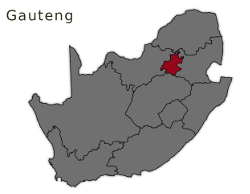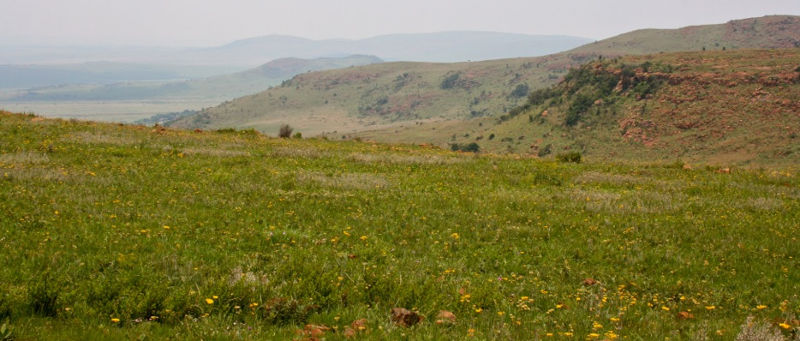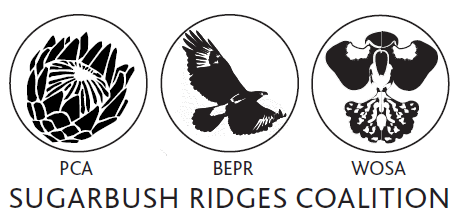 Orchids in Gauteng
Orchids in Gauteng
- Introduction
- Species List
- Species Flowering Months
- Red List Endangered
- Orange List Threatened
- Credits
Wild Orchids of Southern Africa - Is a working group with the aim of promoting knowledge of the indigenous orchids and protecting their habitats by actively engaging with landowners, developers and Nature Conservation officials.
Although many people assume that orchids occur only in tropical areas, South Africa boasts an impressive diversity of orchids. Approximately 56 species of orchid occur within Gauteng's borders alone - some are extremely common, whereas others have only been recorded a handful of times or only once. The typical habitat of Gauteng's orchids is Bankenveld grassland - a biome that has suffered from uncontrolled development, pollution and public ignorance of its ecological importance. In terms of diversity, Bankenveld grassland is the second most diverse biome in the country after the Cape Floristic Region and as such deserves to be protected and appreciated.

The orchids that occur in Gauteng are terrestrial deciduous orchids which means that they grow in a similar manner to bulbs - they are dormant during the dry, cold time of the year and only emerge from the ground when Spring arrives.
Species List and Flowering Months
According to distribution records for Gauteng, the following species occur in the province. The table details the typical flowering time for each species. Due to urbanisation, several of the species listed have become very rare or possibly extinct.
|
|||||||||||||||||
No. |
Species |
Flowering Months |
|||||||||||||||
|
1 |
1 | 2 | 3 | 4 | 5 | 6 | 7 | 8 | 9 | 10 | 11 | 12 | |||||
|
2 |
Bonatea polypodantha |
1 | 2 | 3 | 4 | 5 | 6 | 7 | 8 | 9 | 10 | 11 | 12 | ||||
|
3 |
1 | 2 | 3 | 4 | 5 | 6 | 7 | 8 | 9 | 10 | 11 | 12 | |||||
|
4 |
Bonatea saundersioides |
1 | 2 | 3 | 4 | 5 | 6 | 7 | 8 | 9 | 10 | 11 | 12 | ||||
|
5 |
Brachycorythis conica subsp. transvaalensis |
 |
1 | 2 | 3 | 4 | 5 | 6 | 7 | 8 | 9 | 10 | 11 | 12 | |||
|
6 |
 |
1 | 2 | 3 | 4 | 5 | 6 | 7 | 8 | 9 | 10 | 11 | 12 | ||||
|
7 |
Brachycorythis pubescens |
1 | 2 | 3 | 4 | 5 | 6 | 7 | 8 | 9 | 10 | 11 | 12 | ||||
|
8 |
Brachycorythis tenuior |
1 | 2 | 3 | 4 | 5 | 6 | 7 | 8 | 9 | 10 | 11 | 12 | ||||
|
9 |
Brownleea parviflora * |
1 | 2 | 3 | 4 | 5 | 6 | 7 | 8 | 9 | 10 | 11 | 12 | ||||
|
10 |
Corycium dracomontanum * |
1 | 2 | 3 | 4 | 5 | 6 | 7 | 8 | 9 | 10 | 11 | 12 | ||||
|
11 |
 |
1 | 2 | 3 | 4 | 5 | 6 | 7 | 8 | 9 | 10 | 11 | 12 | ||||
|
12 |
Disa polygonoides * |
1 | 2 | 3 | 4 | 5 | 6 | 7 | 8 | 9 | 10 | 11 | 12 | ||||
|
13 |
Disa versicolor * |
1 | 2 | 3 | 4 | 5 | 6 | 7 | 8 | 9 | 10 | 11 | 12 | ||||
|
14 |
Disa woodii |
1 | 2 | 3 | 4 | 5 | 6 | 7 | 8 | 9 | 10 | 11 | 12 | ||||
|
15 |
Disperis anthoceras |
1 | 2 | 3 | 4 | 5 | 6 | 7 | 8 | 9 | 10 | 11 | 12 | ||||
|
16 |
Disperis micrantha * |
1 | 2 | 3 | 4 | 5 | 6 | 7 | 8 | 9 | 10 | 11 | 12 | ||||
|
17 |
Eulophia adenoglossa |
1 | 2 | 3 | 4 | 5 | 6 | 7 | 8 | 9 | 10 | 11 | 12 | ||||
|
18 |
Eulophia bainesii |
1 | 2 | 3 | 4 | 5 | 6 | 7 | 8 | 9 | 10 | 11 | 12 | ||||
|
19 |
 |
1 | 2 | 3 | 4 | 5 | 6 | 7 | 8 | 9 | 10 | 11 | 12 | ||||
|
20 |
Eulophia coddii |
 |
1 | 2 | 3 | 4 | 5 | 6 | 7 | 8 | 9 | 10 | 11 | 12 | |||
|
21 |
 |
1 | 2 | 3 | 4 | 5 | 6 | 7 | 8 | 9 | 10 | 11 | 12 | ||||
|
22 |
Eulophia foliosa |
1 | 2 | 3 | 4 | 5 | 6 | 7 | 8 | 9 | 10 | 11 | 12 | ||||
|
23 |
 |
1 | 2 | 3 | 4 | 5 | 6 | 7 | 8 | 9 | 10 | 11 | 12 | ||||
|
24 |
 |
1 | 2 | 3 | 4 | 5 | 6 | 7 | 8 | 9 | 10 | 11 | 12 | ||||
|
25 |
 |
1 | 2 | 3 | 4 | 5 | 6 | 7 | 8 | 9 | 10 | 11 | 12 | ||||
|
26 |
Eulophia leontoglossa |
1 | 2 | 3 | 4 | 5 | 6 | 7 | 8 | 9 | 10 | 11 | 12 | ||||
|
27 |
Eulophia milnei * |
1 | 2 | 3 | 4 | 5 | 6 | 7 | 8 | 9 | 10 | 11 | 12 | ||||
|
28 |
Eulophia nutans |
1 | 2 | 3 | 4 | 5 | 6 | 7 | 8 | 9 | 10 | 11 | 12 |
||||
|
29 |
 |
1 | 2 | 3 | 4 | 5 | 6 | 7 | 8 | 9 | 10 | 11 | 12 | ||||
|
30 |
Eulophia parviflora * |
1 | 2 | 3 | 4 | 5 | 6 | 7 | 8 | 9 | 10 | 11 | 12 | ||||
|
31 |
Eulophia speciosa * |
1 | 2 | 3 | 4 | 5 | 6 | 7 | 8 | 9 | 10 | 11 | 12 | ||||
|
32 |
 |
1 |
2 | 3 | 4 | 5 | 6 | 7 | 8 | 9 | 10 | 11 | 12 | ||||
|
33 |
Eulophia tuberculata |
1 | 2 | 3 | 4 | 5 | 6 | 7 | 8 | 9 | 10 | 11 | 12 | ||||
|
34 |
Eulophia zeyheri |
1 | 2 | 3 | 4 | 5 | 6 | 7 | 8 | 9 | 10 | 11 | 12 | ||||
|
35 |
 |
 |
1 | 2 | 3 | 4 | 5 | 6 | 7 | 8 | 9 | 10 | 11 | 12 | |||
|
36 |
Habenaria bicolor * |
 |
1 | 2 | 3 | 4 | 5 | 6 | 7 | 8 | 9 | 10 | 11 | 12 | |||
|
37 |
Habenaria caffra |
1 | 2 | 3 | 4 | 5 | 6 | 7 | 8 | 9 | 10 | 11 | 12 | ||||
|
38 |
Habenaria clavata * |
1 | 2 | 3 | 4 | 5 | 6 | 7 | 8 | 9 | 10 | 11 | 12 | ||||
|
39 |
 |
1 | 2 | 3 | 4 | 5 | 6 | 7 | 8 | 9 | 10 | 11 | 12 | ||||
|
40 |
Habenaria epipactidea |
1 | 2 | 3 | 4 | 5 | 6 | 7 | 8 | 9 | 10 | 11 | 12 | ||||
|
41 |
Habenaria filicornis |
1 | 2 | 3 | 4 | 5 | 6 | 7 | 8 | 9 | 10 | 11 | 12 | ||||
|
42 |
Habenaria galpinii |
1 | 2 | 3 | 4 | 5 | 6 | 7 | 8 | 9 | 10 | 11 | 12 | ||||
|
43 |
Habenaria humilior * |
1 | 2 | 3 | 4 | 5 | 6 | 7 | 8 | 9 | 10 | 11 | 12 | ||||
|
44 |
Habenaria kraenzliniana |
 |
1 | 2 | 3 | 4 | 5 | 6 | 7 | 8 | 9 | 10 | 11 | 12 | |||
|
45 |
Habenaria lithophila |
1 | 2 | 3 | 4 | 5 | 6 | 7 | 8 | 9 | 10 | 11 | 12 | ||||
|
46 |
Habenaria mossii |
 |
1 | 2 | 3 | 4 | 5 | 6 | 7 | 8 | 9 | 10 | 11 | 12 | |||
|
47 |
Habenaria nyikana |
1 | 2 | 3 | 4 | 5 | 6 | 7 | 8 | 9 | 10 | 11 | 12 | ||||
|
48 |
Habenaria pseudociliosa * |
1 | 2 | 3 | 4 | 5 | 6 | 7 | 8 | 9 | 10 | 11 | 12 | ||||
|
49 |
Habenaria schimperiana * |
1 | 2 | 3 | 4 | 5 | 6 | 7 | 8 | 9 | 10 | 11 | 12 | ||||
|
50 |
Habenaria tridens * |
1 | 2 | 3 | 4 | 5 | 6 | 7 | 8 | 9 | 10 | 11 | 12 | ||||
|
51 |
Holothrix micrantha * |
 |
1 | 2 | 3 | 4 | 5 | 6 | 7 | 8 | 9 | 10 | 11 | 12 | |||
|
52 |
 |
 |
1 | 2 | 3 | 4 | 5 | 6 | 7 | 8 | 9 | 10 | 11 | 12 | |||
|
53 |
 |
1 | 1 | 3 | 4 | 5 | 6 | 7 | 8 | 9 | 10 | 11 | 12 | ||||
|
54 |
Satyrium occelatum |
1 | 2 | 3 | 4 | 5 | 6 | 7 | 8 | 9 | 10 | 11 | 12 | ||||
|
55 |
Satyrium parviflorum * |
1 | 1 | 3 | 4 | 5 | 6 | 7 | 8 | 9 | 10 | 11 | 12 | ||||
|
56 |
Satyrium trinerve * |
1 | 2 | 3 | 4 | 5 | 6 | 7 | 8 | 9 | 10 | 11 | 12 | ||||
|
57 |
Schizochilus zeyheri * |
1 | 2 | 3 | 4 | 5 | 6 | 7 | 8 | 9 | 10 | 11 | 12 | ||||
|
* This species has in the past been recorded as present in Gauteng, but is so rare that it has not been found recently, or could be extinct by now due mainly to the urbanisation creep. ** This species has recently been found in our area, but the official distribution information does not cover Gauteng. |
|||||||||||||||||
Red list of Gauteng Endangered Orchids
Habenaria mossii (Endangered)
Holothrix micrantha (Endangered)
Brachycorythis conica subsp. transvallensis (Vulnerable)
Eulophia coddii (Vulnerable)
Orange list of Gauteng Threatened Orchids
Habenaria barbertoni (Near Threatened)
Habenaria bicolor (Near Threatened)
Habenaria kraenzliniana (Near Threatened)
Holothrix randii (Near Threatened)
SANBI Threatened Orchids
Information about Gauteng Legislation
Conservation Areas
Verloren Valei Mpumalanga – A Biodiversity Hotspot among Trout Dams?
Credits
Introduction by Casper van Zyl
Flowering time information compiled by Duncan MacFarlane from the Field Guide to the Orchids of Northern South Africa & Swaziland (D. McMurtry, L. Grobler, J. Grobler, & S. Burns)

